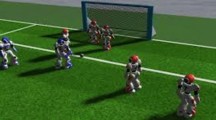Abstract
Studying the optimization of the soccer robot path planning is significant because of the ever-changing situation of the arena. The system itself has non-linearity. The environment also has the characteristics of time varying, which requires the robot to cooperate with each other. Combining with the characteristics of a soccer robot system, this paper proposes a genetic algorithm for the path planning algorithm of a soccer robot, which enables the robot to find a relatively short path from the point to the target. In this paper, three common path-planning methods are introduced, and the advantages and disadvantages are compared. Then, a path planning method based on S-adaptive genetic algorithm is proposed. The main innovation point is to change the crossover probability and mutation probability in genetic operation. Therefore, that it can change the probability value autonomously with the change of genetic generation and individual in the group. This method can better save the effective individual, make the algorithm converges faster, and get the optimal individual under the same conditions. The path solved by S-adaptive algorithm realizes obstacle avoidance behavior in a short time, and the path is better than the traditional genetic algorithm.
















Similar content being viewed by others
References
Abdel-Malek K, Yang J, Blackmore D et al (2006) Swept volumes: fundation, perspectives, and applications[J]. Int J Shape Model 12(01):87–127
Ahmed AA, Abdalla TY, Abed AA (2015) Path planning of mobile robot by using modified optimized potential field method[J]. Int J Comput Appl 113(4):6–10
Camacho D, Novais P (2017) Innovations and practical applications of intelligent systems in ambient intelligence and humanized computing[J]. J Ambient Intell Humaniz Comput 8(2):155–156
Chen MC, Liu QL (2016) Blow-up criteria of smooth solutions to a 3D model of electro-kinetic fluids in a bounded domain[J]. Electron J Differ Equ 2016(128):1–8
Chen MC, Lu SQ, Liu QL (2018) Global regularity for a 2D model of electro-kinetic fluid in a bounded domain[J]. Acta Mathematicae Applicatae Sinica-English Series 34(2):398–403
Elhoseny M, Tharwat A, Hassanien AE (2018) Bezier curve based path planning in a dynamic field using modified genetic algorithm[J]. J Comput Sci 25:339–350
Hidalgo-Paniagua A, Vega-Rodríguez MA, Ferruz J et al (2017) Solving the multi-objective path planning problem in mobile robotics with a firefly-based approach[J]. Soft Comput 21(4):949–964
Hui NB, Biswas T, Samanta S et al (2016) Multi-agent mobile robot navigation through genetic-fuzzy algorithm[J]. GRD J Glob Res Dev J Eng 1(4):53–66
Jaradat MAK, Garibeh MH, Feilat EA (2012) Autonomous mobile robot dynamic motion planning using hybrid fuzzy potential field[J]. Soft Comput 16(1):153–164
Khatib R, Schnarr D (1985) Point-source outbreak of mycoplasma pneumoniae infection in a family unit[J]. J Infect Dis 151(1):186–187
Kim JH, Kim YH, Choi SH et al (2009) Evolutionary multi-objective optimization in robot soccer system for education[J]. IEEE Comput Intell Mag 4(1):31–41
Kuo PH, Li THS, Chen GY et al (2016) A migrant-inspired path planning algorithm for obstacle run using particle swarm optimization, potential field navigation, and fuzzy logic controller[J]. Knowl Eng Rev 32(158):1–17
Lee J, Kim DW (2016) An effective initialization method for genetic algorithm-based robot path planning using a directed acyclic graph[J]. Inf Sci 332:1–18
Li SA, Chou LH, Chang TH et al (2019) Obstacle avoidance of mobile robot based on hyperomni vision[J]. Sens Mater 31(3):1021–1036
Mac TT, Copot C, Tran DT et al (2017) A hierarchical global path planning approach for mobile robots based on multi-objective particle swarm optimization[J]. Appl Soft Comput 59:68–76
Mohanan MG, Salgoankar A (2018) A survey of robotic motion planning in dynamic environments[J]. Robot Auton Syst 100:171–185
Montiel O, Sepúlveda R, Orozco-Rosas U (2015) Optimal path planning generation for mobile robots using parallel evolutionary artificial potential field[J]. J Intell Rob Syst 79(2):237–257
Sheng QZ, Shakshuki EM, Ma J (2014) Advances in ambient intelligence technologies[J]. J Ambient Intell Humaniz Comput 5(3):341–342
Song B, Wang Z, Zou L (2017) On global smooth path planning for mobile robots using a novel multimodal delayed PSO algorithm[J]. Cognitive Computation 9(1):5–17
Srinivas M, Patnaik LM (1994) Adaptive probabilities of crossover and mutation in genetic algorithms[J]. IEEE Trans Syst Man Cybern 24(4):656–667
Zeng Z, Lian L, Sammut K et al (2015) A survey on path planning for persistent autonomy of autonomous underwater vehicles[J]. Ocean Eng 110:303–313
Zhang Z, Lin SL, Zhu QD et al (2015) Genetic collision avoidance planning algorithm for irregular shaped object with kinematics constraint[J]. Acta Aeronautica et Astronautica Sinica 36(4):1348–1358
Zhang H, Lin W, Chen A (2018) Path planning for the mobile robot: a review[J]. Symmetry 10(10):450
Zhu J (2016) Control improvement of soccer robot motion based on genetic algorithm[J]. Rom Rev Precis Mech Opt Mechatron 2016(50):281–285
Zhu DQ, Sun B, Li L (2015) Algorithm for AUVs 3-D path planning and safe obstacle avoidance based on biological inspired model[J]. Control Decis 30(5):798–806
Acknowledgements
The authors acknowledge the 13th five-year plan of jiangxi education science, the subject of “Research on Compensation Mechanism of Physical Health Education in Rural Primary Schools of Ganjiang New District” in 2019 (No. 19YB232).
Author information
Authors and Affiliations
Corresponding author
Additional information
Publisher's Note
Springer Nature remains neutral with regard to jurisdictional claims in published maps and institutional affiliations.
Rights and permissions
About this article
Cite this article
Chen, X., Gao, P. Path planning and control of soccer robot based on genetic algorithm. J Ambient Intell Human Comput 11, 6177–6186 (2020). https://doi.org/10.1007/s12652-019-01635-1
Received:
Accepted:
Published:
Issue Date:
DOI: https://doi.org/10.1007/s12652-019-01635-1




